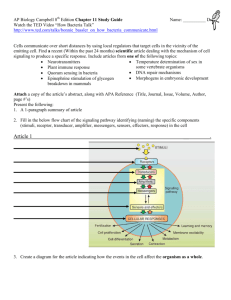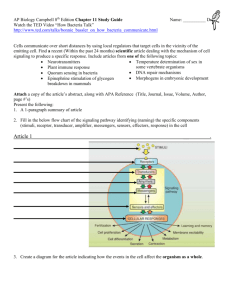AP Biology - Cell Signaling Diseases Project
advertisement
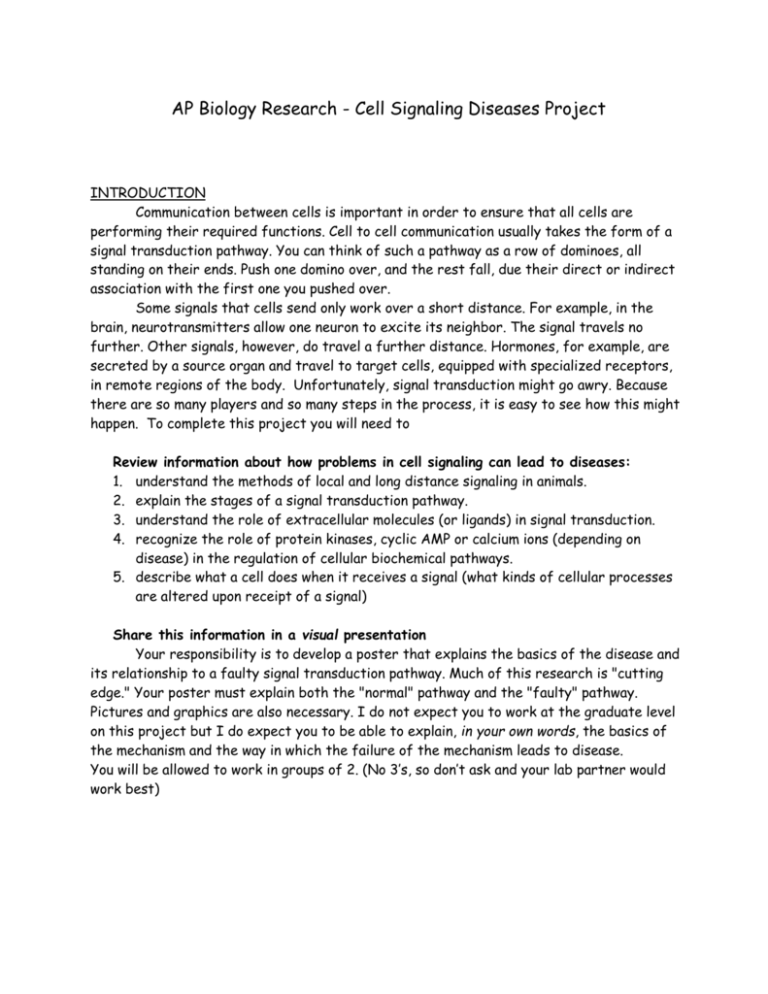
AP Biology Research - Cell Signaling Diseases Project INTRODUCTION Communication between cells is important in order to ensure that all cells are performing their required functions. Cell to cell communication usually takes the form of a signal transduction pathway. You can think of such a pathway as a row of dominoes, all standing on their ends. Push one domino over, and the rest fall, due their direct or indirect association with the first one you pushed over. Some signals that cells send only work over a short distance. For example, in the brain, neurotransmitters allow one neuron to excite its neighbor. The signal travels no further. Other signals, however, do travel a further distance. Hormones, for example, are secreted by a source organ and travel to target cells, equipped with specialized receptors, in remote regions of the body. Unfortunately, signal transduction might go awry. Because there are so many players and so many steps in the process, it is easy to see how this might happen. To complete this project you will need to Review information about how problems in cell signaling can lead to diseases: 1. understand the methods of local and long distance signaling in animals. 2. explain the stages of a signal transduction pathway. 3. understand the role of extracellular molecules (or ligands) in signal transduction. 4. recognize the role of protein kinases, cyclic AMP or calcium ions (depending on disease) in the regulation of cellular biochemical pathways. 5. describe what a cell does when it receives a signal (what kinds of cellular processes are altered upon receipt of a signal) Share this information in a visual presentation Your responsibility is to develop a poster that explains the basics of the disease and its relationship to a faulty signal transduction pathway. Much of this research is "cutting edge." Your poster must explain both the "normal" pathway and the "faulty" pathway. Pictures and graphics are also necessary. I do not expect you to work at the graduate level on this project but I do expect you to be able to explain, in your own words, the basics of the mechanism and the way in which the failure of the mechanism leads to disease. You will be allowed to work in groups of 2. (No 3’s, so don’t ask and your lab partner would work best) Here are some additional good places to start: http://fig.cox.miami.edu/~cmallery/150/memb/cellcomm.htm http://www.case.edu/pubaff/univcomm/cell-rsch.htm http://www.cellsignal.com/reference/pathway/index.jsp http://anatomy.med.unsw.edu.au/cbl/GENOME/Genes_Diseases/Signals/signals_overview.htm http://www.news-medical.net/?id=72 http://www.emedicine.com/ http://www.bioteach.ubc.ca/CellBiology/CellSurfaceReceptors/ http://rarediseases.info.nih.gov/ http://www.cellsignallingbiology.org/ http://www.kumc.edu/gec/support http://www.ygyh.org http://www.ncbi.nlm.nih.gov/projects/genome/guide/human/ http://medgen.genetics.utah.edu/photographs.htm http://www.sigmaaldrich.com/Area_of_Interest/Life_Science/Cell_Signaling/Scientific_R esources/Pathway_Slides___Charts.html http://www.genome.gov/ Grading: Total Points – 50 Format - poster - 10 points (will either stand alone or against a wall) Size - 20" X 30" (this is typical, can be smaller) All information must be typed; use headings and appropriate font sizes Pictures and graphics included; at least three including o A drawing of the chromosome showing the location of the affected gene. o A picture or drawing of a person with the genetic disease or a picture or drawing of organs and/or tissues affected by the disease. o A picture or drawing of the type of cell signaling pathway(s) involved. (working pathway and/or faulty pathway) Neat/colorful presentation - no spelling or grammatical errors Include name(s), Course & Block in lower right corner of poster Include list of sources used for project (MLA) on back of poster Content - 40 points Disease - basics only - cause and core symptoms Cell signaling pathway involved Correct mechanism Incorrect mechanism Graphics of pathway Current direction of research Disease Choices Ataxia Telangiectasia (AT) Heart Disease - Congenital Heart Disease or Cardiomyocyte Hypertrophy Kidney Disease Parkinson's disease and calcium channels Multiple Sclerosis Pancreatic Cancer Chronic Myelogenous Leukemia (CML) Alzheimer Disease Tuberous Sclerosis Neurofibromatosis Alopecia Diabetes and Insulin Resistance Cockayne Syndrome Asthma/Allergies Cystic Fibrosis Werner Syndrome Norrie Disease

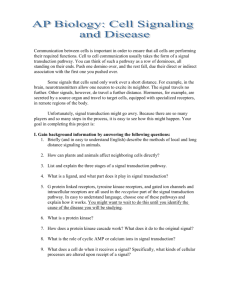
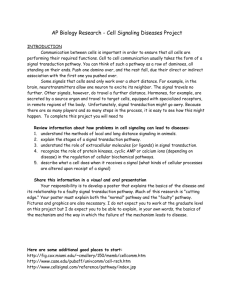

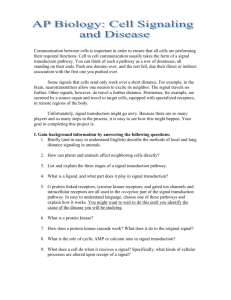



![Major Change to a Course or Pathway [DOCX 31.06KB]](http://s3.studylib.net/store/data/006879957_1-7d46b1f6b93d0bf5c854352080131369-300x300.png)

